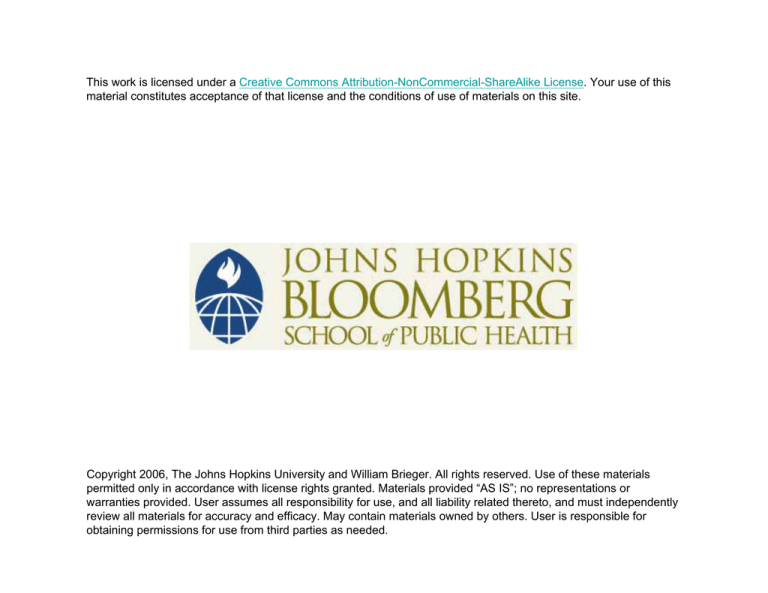
This work is licensed under a Creative Commons Attribution-NonCommercial-ShareAlike License. Your use of this
material constitutes acceptance of that license and the conditions of use of materials on this site.
Copyright 2006, The Johns Hopkins University and William Brieger. All rights reserved. Use of these materials
permitted only in accordance with license rights granted. Materials provided “AS IS”; no representations or
warranties provided. User assumes all responsibility for use, and all liability related thereto, and must independently
review all materials for accuracy and efficacy. May contain materials owned by others. User is responsible for
obtaining permissions for use from third parties as needed.
Community Change Models
William R. Brieger, MPH, CHES, DrPh
Johns Hopkins University
1
Community/Social Change
The Functionalist View
Ù Social change occurs when parts of
the system break down or are no
longer able to contribute to system
maintenance—or when external or
environmental changes overwhelm the
system
Ù Social norms change, providing new
rules of conduct to help reform and
maintain the system
2
The Conflict View
Ù Change occurs when one of several
interests in a system gains
ascendancy
Ù Social norms also play a role in this
perspective—not as a basis of
consensus but as a foundation for
coercion
Continued
3
The Conflict View
Ù Those who control parts of the system
(economic, political, etc) are seen as
the ones who establish and enforce
the norms, and attempts to change
norms are thought to be resisted
strongly by these controlling interests
Continued
4
The Conflict View
Ù A change in social norms from this
perspective will result when an
opposing interest group is able to exert
more influence over the system or
parts of the system that the existing
controlling interests
5
Rothman’s Models of
Community Change
Ù
Ù
Ù
Ù
Social policy planning
Locality development
Social action
Social mobilization
6
Models of Community Change
Rothman
Ù Social Policy Planning
– Experts design programs for
communities (resembles empiricalrational change), provide leadership
Ù Community action
– Community members organize
themselves to redress imbalances in
power, distribution/access of
resources
Continued
7
Models of Community Change
Rothman
Ù Community Development
– Self-help through mobilization of
local resources (resembles
normative re-educative change)
Ù Community Mobilization
– Programs are externally designed,
but community members are
expected to contribute resources
8
Social Policy Planning
Ù Typical agency-centered (expert)
approach
Ù Empirical-rational in philosophy
Ù Prime example is city and regional
planning authorities
Continued
9
Social Policy Planning
Ù In health, we observe rates, outbreaks,
and trends—and plan programs to
address those
Ù Planning about the problem, not about
the people
Ù Appeals to ready responders
Ù These days, relies on social marketing
10
Community Action
(A Conflict Perspective)
Ù Redresses imbalances of power,
resource allocation within a community
Ù Concerns empowerment
Ù Acknowledging that empowerment is
something people do for themselves
Continued 11
Community Action
(A Conflict Perspective)
Ù A power-coercive approach to change
Ù Change agent as organizer helps the
community identify pressure points
Ù Media advocacy plays a role in getting
the attention of decision makers
12
Community action
13
Locality Development
Ù Normative re-educative in approach
Ù Builds on community capacity
Ù Goal is for problem-solving ability to be
sustained
Ù Emphasizes community control
Continued 14
Locality Development
Ù Change agent is a facilitator
– Primary expertise in process
Ù Emphasizes indigenous knowledge
– Offer mechanisms to organize for
change
– Local technologies to enable
change
15
Community Mobilization
Ù Also expert/agency-oriented
Ù Broad scale effort to bring people
together for action
– Specific program/goal orientation
– For example, immunization
campaign and coverage
Continued 16
Community Mobilization
Ù Emphasizes contributions from
– Other agencies
– Community members and social
groups themselves
Ù Related to social marketing (creating a
demand)
– Issue of manipulation arises
17
Forms of Community Change
Ù Process
– The community is part of the
process of change, part of what
changes
– New structures, new norms, new
relationships that strengthen the
community’s problem adaptation
and/or solving capacity
Continued 18
Forms of Community Change
Ù Process
– For sustainability, this form of
community change can build on the
strengths of indigenous
community-based organizations
(CBOs), recognizing that such
organizations are already engaged
in the development and
maintenance of the community
Continued 19
Forms of Community Change
Ù Process
– Strategies include community
organization and advocacy, based
on social learning and community
capacity theories
Continued 20
Forms of Community Change
Ù Content
– The community is the context for
individual change
– Using existing organizations, social
networks, and communication
channels to promote
specific/targeted behavior changes
of individual community members
Continued 21
Forms of Community Change
Ù Strategies include
– Community mobilization
– Social marketing
– Based on diffusion theory
22
Source of Resources
and Leadership
Leadership
Resources
Internal
External
Internal
External
Locality
Development
Social
Mobilization
Social Action
Social Policy
Planning
23





